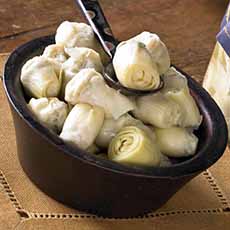TIP OF THE DAY: Hearts Of Palm
|
Back in the day when we still seriously dieted, we created what we called a luxury salad—absolutely delicious and “luxurious” because the ingredients were relatively costly. Whenever we’re feeling diet-minded—or simply want to detox from the rich foods we eat all day, we whip one up. If you can get to a club store, artichoke hearts and hearts of palm are more affordable. Hearts of palm are best chilled or at room temperature, and thus best with cold dishes. Add chopped hearts of palm to: Ingredients Just combine and serve! Hearts of palm are the edible hearts of young palm trees— the edible inner portion of the stem. Palm branches are harvested and cut; the bark and leaves are removed to expose the tender inner core. Hearts of palm have a smooth, firm consistency, a snap to the bite, and a delicate flavor reminiscent of artichokes (they can be used as a substitute for artichokes in a recipe). The hearts can be white or pale yellow, depending on whether the palms are wild or cultivated. |
 [1] Hearts of palm (photo © Foodesto).
|
|
|
The cream-colored stalks resemble white asparagus, minus the tips. However, unlike asparagus, the palm hearts are nested layers. You can peel the layers apart (not that you’d want to). Hearts of palm have only 50 calories per cup, are a great source of dietary fiber, and are a good source of protein, ribolavin, potassium, vitamin C, folate, calcium, iron, magnesium, phosphorus, manganese, copper, and zinc. The only caveat: They can be packed in water with a high sodium content. Due to poaching in Brazil, Ecuador is now the largest producer and exporter of hearts of palm. Costa Rica is the largest exporter of to the U.S, and Hawaii also produces some palm hearts. They are also harvested from Florida’s official state tree, the Cabbage Palm. |
||




